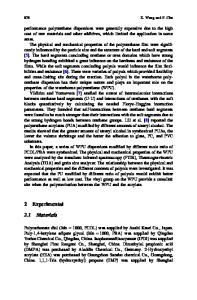The Triple-Shape Memory Effect of Polyurethane Composite Material
- PDF / 528,870 Bytes
- 5 Pages / 612 x 792 pts (letter) Page_size
- 50 Downloads / 334 Views
iple-Shape Memory Effect of Polyurethane Composite Material T. A. Shalyginaa,b*, S. Yu. Voroninaa,b, A. Yu. Vlasovb, K. A. Pasechnika,b, I. V. Obvertkina,b, and M. A. Titov a,b a Reshetnev
b
Siberian State University of Science and Technology, Krasnoyarsk, 660037 Russia Federal Research Center “Krasnoyarsk Science Center, Siberian Branch of the Russian Academy of Sciences, Krasnoyarsk, 660036 Russia *e-mail: [email protected] Received February 18, 2020; revised April 2, 2020; accepted July 22, 2020
Abstract—We have investigated the effect of the finishing layer of carbon fibers on the appearance of the triple-shape memory effect of polyurethane carbon fiber. Structural changes in a polyurethane sample reinforced with finished carbon fiber were determined using thermomodulated differential scanning calorimetry. The effect of the diffusion adhesion mechanism on the thermomechanical characteristics of the triple-form memory effect of polyurethane composite material has been determined. Keywords: triple-shape memory effect, diffusion adhesion mechanism, finish, carbon-fiber-reinforced plastic, polyurethane, temperature-modulated differential scanning calorimetry. DOI: 10.1134/S1063785020100284
The triple-shape memory effect (TSME) of polymeric materials is a special case of the classical double-shape memory effect, characterized by the ability to “memorize” an additional temporary shape. Materials with TSME can pass two-level transformations corresponding to different values of temperature exposure and enable solving more complex problems of science and technology. The appearance of the TSME in polymeric materials is primarily due to a certain ratio of low-temperature (flexible) and high-temperature (rigid) molecular phases in their structure [1, 2]. The rigid phase is responsible for the achievement and fixation of the intermediate shape upon cooling below its temperature transition [3–5]. Therefore, the goal of this work is to increase the proportion of the rigid molecular phase in the structure of a polyurethane matrix, the significant predominance of the flexible phase in which restricts the manifestation of the TSME. We based ourselves on the fact that, in the production of carbon fiber, which is a reinforcing material in the sample under study, its surface is coated with a polymer finish. In the manufacture of polyurethane carbon fiber, diffusion adhesion can occur at the interface between two polymers (in this case, a polymer finish and a polyurethane binder), which promotes the formation of a transition layer with an increased packing density [6]. The mobility of the segments of the polyurethane matrix, involved in the diffusion process, can decrease either due to a purely physical restriction or by the formation of phys-
ical bonds with the molecular chains of the polymer finish, while the ratio of flexible and rigid segments shifts toward the latter, which contributes to the manifestation of the TSME. We used the following samples as objects of investigation of the effect of the finishing layer of carbon
Data Loading...











